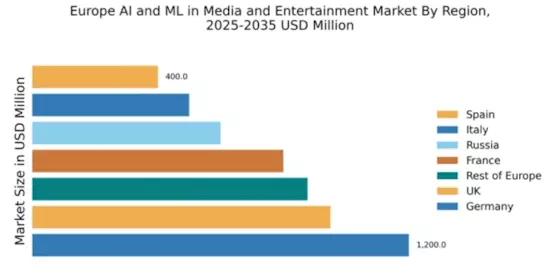Advancements in Data Analytics
The ai ml-in-media-and-entertainment market is significantly influenced by advancements in data analytics capabilities. With the proliferation of digital content, companies are increasingly relying on sophisticated analytics tools to understand audience preferences and behaviors. In Europe, the market for data analytics in media is expected to reach €5 billion by 2026, reflecting a growing recognition of the value of data-driven decision-making. These analytics enable media companies to tailor their offerings, optimize marketing strategies, and enhance user experiences. As a result, the integration of advanced analytics into content strategies is becoming a critical driver for growth in the ai ml-in-media-and-entertainment market.
Regulatory Support for Innovation
Regulatory support for innovation plays a pivotal role in shaping the ai ml-in-media-and-entertainment market. European governments are increasingly recognizing the potential of AI technologies to drive economic growth and enhance cultural offerings. Initiatives aimed at fostering innovation, such as funding programs and tax incentives for tech development, are becoming more prevalent. For instance, the European Commission has allocated €1 billion to support AI research and development in the creative industries. This regulatory environment encourages media companies to adopt AI solutions, thereby accelerating the growth of the ai ml-in-media-and-entertainment market and ensuring that Europe remains competitive on the global stage.
Investment in AI-Driven Technologies
Investment in AI-driven technologies is a crucial driver for the ai ml-in-media-and-entertainment market. European media companies are increasingly allocating resources towards the development and implementation of AI solutions to streamline operations and enhance content quality. This trend is evidenced by a reported increase in funding for AI startups in the media sector, which reached €1.2 billion in 2025. Such investments are aimed at automating processes, improving content curation, and enhancing user engagement through personalized recommendations. As these technologies mature, they are likely to reshape the competitive landscape of the media industry, further propelling the ai ml-in-media-and-entertainment market.
Emergence of New Distribution Channels
The emergence of new distribution channels is reshaping the ai ml-in-media-and-entertainment market. With the rise of streaming platforms and digital distribution, content creators are exploring innovative ways to reach audiences. This shift is accompanied by a growing reliance on AI and machine learning to optimize content delivery across various platforms. In Europe, the number of streaming subscribers is projected to exceed 100 million by 2027, highlighting the importance of adapting to changing consumer behaviors. As media companies leverage these new channels, they are likely to enhance their market presence and drive growth in the ai ml-in-media-and-entertainment market.
Rising Demand for Interactive Experiences
The ai ml-in-media-and-entertainment market is witnessing a notable increase in demand for interactive experiences among consumers. This trend is driven by the growing expectation for personalized and engaging content. As audiences seek more immersive experiences, companies are investing in technologies that leverage artificial intelligence and machine learning to create interactive narratives and adaptive storytelling. In Europe, the market for interactive media is projected to grow at a CAGR of 15% from 2025 to 2030, indicating a robust appetite for innovative content formats. This shift not only enhances viewer engagement but also opens new revenue streams for content creators, thereby propelling the ai ml-in-media-and-entertainment market forward.


















Leave a Comment